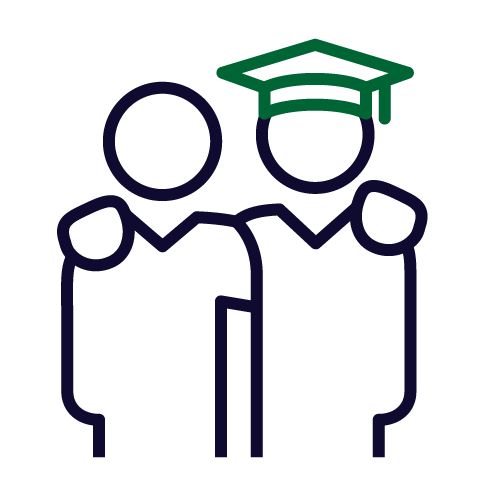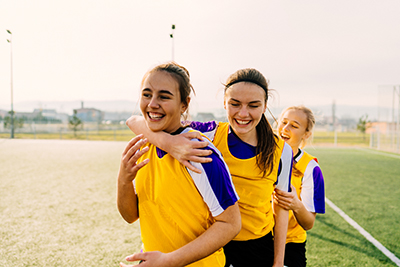EDUCATION
- improved cognitive development, learning and retaining information
- building critical life skills
- staying in school longer
- higher lifetime earnings.
THE ROLE OF SPORT

SPORT IN EDUCATION ACROSS THE LIFECOURSE
CHALLENGES
There is no available national data on how many primary or secondary schools schedule the delivery of physical education (PE) and other planned physical activities such as school sport. 40
Reports and evidence suggest that the current generation of Australian children and adolescents are not receiving the optimal benefits that sport and physical activity can provide. 40, 41 We also know that children are less likely to participate in sport when they have a low level of physical, cognitive, psychological, and social skills relating to movement (i.e., low physical literacy). 29
Crowded school curriculums, with multiple converging and possibly conflicting priorities, mean that sport is often seen as an extra or a ‘value add’ rather than an integral part of developing healthy and active lives. 40, 41, 42
Sport and physical activity can be powerful tools in helping children and young people to achieve their physical, academic, and social potential. The biggest benefits are produced through whole-of-school and society approaches using a variety of tools and techniques to motivate students, teachers, and parents to get involved and get active. 40, 42, 43, 44, 45, 46
- Athletics and executive functioning: How athletic participation and sport type correlate with cognitive performance, Jacobson J and Matthaeus L, Psychology of Sport and Exercise, Volume 15(5), pp.521-527, (September 2014).
- Sport Values in Every Classroom: harnessing the power of sport to teach respect, equity and inclusion, United Nations Educational, Scientific and Cultural Organization (UNESCO), Olympic Foundation for Culture and Heritage (OFCH), Agitos Foundation, World Anti-Doping Agency (WADA), International Council of Sport Science and Physical Education (ICSSPE/CIEPSS), (2019).
- How sport can help young people to become better citizens, Vaughan Cruickshank, Casey Peter Mainsbridge, The Conversation, (23 February 2022).
- Afterschool school triathlon training for 11- to 14-year old girls: Influences on academic motivation and achievement, Jennifer Gatz, Angela Kelly, Health Education Journal, Volume 77(2), pp.156-168, (March 2018)
- The impact of engagement in sport on graduate employability: implications for higher education policy and practice, Kerry Griffiths, Steve Bullough, Simon Shibli, et al., International Journal of Sport Policy and Politics, Volume 9(3), pp.431-451, (2017).
- The health and educational impact of removing financial constraints for school sport, Lauren Denise Sulz, Doug Lee Gleddie, Cassidy Kinsella, et al., European Physical Education Review, Volume 29(1), (June 2022).
- Intergenerational review of Australian sport, BCG Consulting for the Australian Sports Commission, (2017).
- Is the lack of physical activity strategy for children complicit mass child neglect? Weiler R, Allardyce S, Whyte G and Stamatakis E, British Journal of Sports Medicine, Volume 48(13), pp.1010-1013, (June 2014).
- The WHO Health Promoting School framework for improving the health and well-being of students and their academic achievement, Rebecca Langford, Christopher Bonell, Hayley Jones, et.al., Cochrane Database of Systematic Reviews, (April 2014).
- Can Sports Practice in Childhood and Adolescence Be Associated with Higher Intensities of Physical Activity in Adult Life? A Retrospective Study in Community-Dwelling Adults, Gabriela Silva, William Tebar, Italo Lemes, et al., International Journal of Environmental Research and Public Health, Volume 19(22), (November 2022).
- Active Schools, Active Kids, Active Communities: A Joint Ministerial Statement on Physical Activity for Children and Young People, Victorian State Government, (2020).
- Organized Youth Sports Trajectories and Adult Health Outcomes: The Young Finns Study, Xiaolin Yang, Tuomas Kukko, Irinja Lounassalo, et al., American Journal of Preventive Medicine, Volume 63(6), pp.962-970, (December 20220).
- The role of past campus recreational sports participation in predicting students’ stress and competence during the COVID-19 pandemic, Narges Abdeahad, Steven Mock, Journal of Leisure Research, Volume 54(2), pp.269-285, (2023).
- Relationship of participation in specific sports to academic performance in adolescents: A 2‐year longitudinal study, Toru Ishihara, Toshihiro Nakajima, Koji Yamatsu, et al., Scandinavian Journal of Medicine and Science in Sports, Volume 30(8), pp.1471-1482, (August 2020).
- Out of school activities during primary school and KS2 attainment, Chanfreau J, Tanner E, Callanan M, et al., Centre for Longitudinal Studies, National Centre for Social Research, United Kingdom, Working Paper, (2016).
- Sport participation and academic performance in children and adolescents: A systematic review and meta-analysis, Katherine Owen, Bridget Foley, Katrina Wilhite, et al., Medicine and Science in Sport and Exercise, Volume 54(2), pp.299-306, (February 2022).
- After the Siren: The community benefits of Indigenous participation in Australia Rules Football, Michael Dockery and Sean Gorman, Bankwest Curtin Economics Centre, (September 2017).
- Sport and academic performance in Australian Indigenous children, Dorothea Dumuid, Rachel Wilson, Timothy Olds, et al., Australian Journal of Education, Volume 65(1), pp.103-116, (2021).
- The impact of physical activity and sport on social outcomes among Aboriginal and Torres Strait Islander people: A systematic scoping review, Rona Macniven, Karla Canuto, Rachel Wilson, et.al., Journal of Science and Medicine in Sport, Volume 22(11), pp.1232-1242, (2019).
- The effects of a community and school sport-based program on urban Indigenous adolescents’ life skills and physical activity levels: The SCP case study, Louisa Peralta, Donna O’Connor, Wayne Cotton, et al., Health, Volume 6(18), (2014).
- Educational Outcomes of Adolescents Participating in Specialist Sport Programs in Low SES Areas of Western Australia: A Mixed Methods Study, Eibhlish O'Hara, Craig Harms, Fadi Ma'ayah, et al., Frontiers in Psychology, Volume 12, (May 2021).
- The Value of Sport in Higher Education, Don Knapp, Brett Carter, UniSport Australia, (March 2018).
- To Be a Sportsman? Sport Participation Is Associated With Optimal Academic Achievement in a Nationally Representative Sample of High School Students, Sitong Chen, Xiaoyun Li, Jin Yan, Frontiers Public Health, Volume 9, (September 2021).
- Associations between organised sport participation and classroom behaviour outcomes among primary school-aged children, Amanda Watson, Anna Timperio, Helen Brown, et al., PLOS One, (January 2019).
- Effects of 8-Week FIFA 11+ for Kids Intervention on Physical Fitness and Attention in Elementary School Children, Wen-Yen Tseng, Ghazi Rekik, Chia-Hui Chen, et al., Journal of Physical Activity and Health, Volume 18(6), pp.686-693, (2021).
- Open-Skilled Sport, Sport Intensity, Executive Function, and Academic Achievement in Grade School Children, Derek Becker, Megan McClelland, G. John Geldhof, et al., Early Education and Development, Volume 29(7), pp.939-955, (2018).
- ‘It was the best five years of my life!’ How sports programs are keeping disadvantaged teens at school, Eibhlish O'Hara, The Conversation, (27 October 2021).
- Re-engaging ‘youth at risk’ of disengaging from schooling through rugby league club partnership: unpacking the pedagogic practices of the Titans Learning Centre, Susan Whatman, Katherine Main, Sport, Education and Society, Volume 23(4), pp.339-353, (2018).
- Active Lives: Children & Young People Survey - Attitudes towards sport and physical activity, Sport England, (March 2019).
- Physical Literacy, Australian Sports Commission, (accessed 23 January 2024).
- Australian Early Development Census National Report 2021: Early Childhood Development in Australia, Department of Education, Skills and Employment on behalf of the Australian Government, (April 2022).
- Associations between physical activity, motor skills, executive functions and early numeracy in preschoolers, Anssi Vanhala, Eero Haapala, Arja Sääkslahti, et al., European Journal of Sport Science, Volume 23(7), pp.1385-1393, (2023).
- Sport in Education, Clearinghouse for Sport, (accessed 23 January 2024).
- Physical literacy and policy alignment in sport and education in Australia, Joseph Scott, Susan Hill, Donna Barwood, et al., European Physical Education Review, Volume 27(2), (September 2020).
- The associations between physical activity, sedentary behaviour and academic performance), Maher C, Katzmarzyk P, Dumuid D, et.al., Journal of Science and Medicine in Sport, Volume 19(12), pp.1004-1009, (December 2016).
- The longitudinal study of Australian children: 2015 Annual Report: Chapter 5, Australian children’s screen time and participation in extracurricular activities, Maggie Yu and Jennifer Baxter, Growing up in Australia, Australian Institute of Family Studies, (September 2016).
- Cancer Council Victoria. Selected results of the 2018 National Secondary Students' Diet and Activity (NaSSDA) survey. Published and unpublished data. Cancer Council Victoria; 2021, in Reboot! Reimagining Physically Active Lives: 2022 Australian Report Card on Physical Activity for Children and Young People, Active Healthy Kids Australia, (2022).
- The Impact of Engagement in Sport on Graduate Employability: Final report, Kerry Allen, Steve Bullough, Doug Cole, et al., Sheffield Hallam University for British Universities & Colleges Sport (BUCS), (2013).
- Extracurricular activities, graduate attributes and serious leisure: competitive sport versus social-cultural clubs in campus life, Carmel Foley, Simon Darcy, Anja Hergesell, et al., Leisure Studies, Volume 42(6), pp.971-988, (2023).
- Reboot! Reimagining Physically Active Lives: 2022 Australian Report Card on Physical Activity for Children and Young People, Active Healthy Kids Australia, (2022).
- Can’t throw, can’t catch: Australian kids are losing that sporting edge, James Rudd, The Conversation, (29 January 2015).
- Ready, set, go for physical activity, The Lancet, Volume 381(9882), pp.1960, (June 2013).
- Active Lives: Children & Young People Survey – Academic year 2022-23, Sport England, (December 2023).
- Active School Flag: ‘Finding the Fit’, Karen Cotter, ISPAH, (January 2023).
- School Sports Playbook: Develop every student through sports, Aspen Institute, (2022).
- Comprehensive Policies to Support Comprehensive Practices: Physical Activity in Elementary Schools, Hannah Calvert, Lindsey Turner, Julien Leider, et al., Journal of Physical Activity and Health, Volume 17(3), pp.313-322, (2020).
- Sport Participation for Academic Success: Evidence From the Longitudinal Study of Australian Children, Katherine Owen, Bridget Foley, Ben Smith, et al., Journal of Physical Activity and Health, (23 December 2023).
RELATED TOPICS
Discover more about the value and benefits of sport.
Last updated: 23 January 2024
Content disclaimer: See Clearinghouse for Sport disclaimer
IS THIS INFORMATION COMPLETE?
The Clearinghouse for Sport is a sector-wide knowledge sharing initiative, and as such your contributions are encouraged and appreciated. If you would like to suggest a resource, submit a publication, or provide feedback on this topic, please contact us.
Alternatively, if you would like to be kept up to date with research and information published about this topic, please request a research profile setup.





